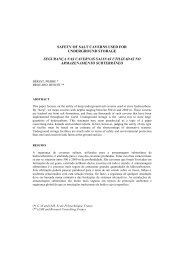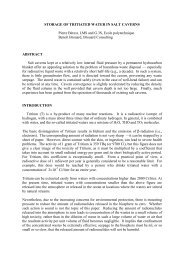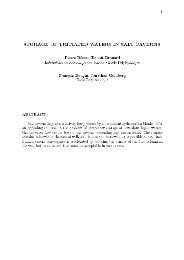Deep salt-cavern abandonment - Brouard Consulting
Deep salt-cavern abandonment - Brouard Consulting
Deep salt-cavern abandonment - Brouard Consulting
Create successful ePaper yourself
Turn your PDF publications into a flip-book with our unique Google optimized e-Paper software.
deviatoric stresses developed at the <strong>cavern</strong> wall when<br />
the <strong>cavern</strong> fluid pressure is very high or very low,<br />
respectively.) For instance, Doe & Osnes (2006)<br />
performed tests in Kansas wells, where they found that<br />
the wells exhibited composite behavior in which the<br />
material near the well had a higher permeability than<br />
the material farther away, possibly reflecting a<br />
borehole damage zone.<br />
Uncertainties remain, and the present state of<br />
knowledge does not allow for blind predictions (i.e.<br />
predictions based on laboratory measurements). In<br />
situ tests must be performed before decommissioning<br />
a <strong>cavern</strong>. Note that, as far as possible, in situ tests<br />
must not be used to back-calculate model parameters,<br />
but, rather, to check that model parameters, which are<br />
to be determined independently, were assessed<br />
accurately before the test. In fact, <strong>cavern</strong><br />
compressibility, brine thermal expansion and brine<br />
leaks can be measured accurately, but the same cannot<br />
be said of the rate of <strong>cavern</strong> creep closure and rock<br />
permeability. Orders of magnitude are known (e.g.<br />
hyd<br />
K<strong>salt</strong><br />
belongs a priori to the range 10 -22 m 2 to 10 -18 m 2 ;<br />
the rate of <strong>cavern</strong> creep closure in an (opened) 1000-m<br />
deep <strong>cavern</strong> typically is 3x10 -4 year -1 , and the actual<br />
figure can be faster or lower by one order of<br />
magnitude).<br />
4 INTERPRETING ABANDONMENT TESTS<br />
For the reasons explained above, one must try to<br />
assess separately the four effects that explain pressure<br />
build-up during an <strong>abandonment</strong> test. Pressure<br />
evolution must be observed for a sufficiently long<br />
“observation period”. The objective of the test is to<br />
prove that an accurate prediction can be made. It was<br />
said that pressure increase (or decrease) rate, effects of<br />
thermal expansion and leaks can be measured<br />
accurately or predicted. They simply provide an<br />
estimation of the difference between brine permeation<br />
effects and <strong>cavern</strong>-creep closure effects:<br />
( β β ) ( α α )<br />
Q − Q = + VP − + VT + Q (19)<br />
creep perm c b c b leak<br />
Assessing each of these two effects ( Q<br />
creep<br />
and<br />
Q<br />
perm<br />
) separately is more difficult, and assumptions<br />
must be made. It generally is assumed that <strong>salt</strong><br />
permeation is governed by the steady-state Darcy law<br />
and that <strong>cavern</strong> creep closure is governed by steadystate<br />
creep — two assumptions that are somewhat<br />
arguable. Salt formation permeability and Norton-Hoff<br />
parameters then can be back-calculated through an<br />
optimization process (Section 5).<br />
However, transient effects also play a significant<br />
role and make test interpretation trickier. The test<br />
often consists of a trial-and-error process to assess the<br />
various effects that take place when the <strong>cavern</strong> is<br />
submitted to different brine pressure levels: the <strong>cavern</strong><br />
pressure is changed periodically through injection or<br />
withdrawal of a liquid [It is important to check that<br />
such movements do not result in a change in well<br />
fluids density, because the relation between well<br />
pressures (which can be measured easily) and <strong>cavern</strong><br />
pressure (which must be assessed correctly) must be<br />
known.] One important drawback of this testing<br />
strategy (which allows <strong>cavern</strong> response to various<br />
pressure conditions to be explored) is that any rapid<br />
pressure change triggers transient effects that blur the<br />
general picture for a time. (For example, after an<br />
increase in pressure, “reverse” <strong>salt</strong> creep seems to<br />
take place and <strong>cavern</strong> volume increases for a time,<br />
making <strong>cavern</strong> convergence negative (Karimi et al.<br />
2007). For this reason, the transient evolution of<br />
<strong>cavern</strong> pressure must be computed. In <strong>Brouard</strong><br />
<strong>Consulting</strong> et al. (2006), a dedicated software program<br />
(LOCAS, <strong>Brouard</strong> et al., 2006) is described that takes<br />
into account the various transient effects that affect a<br />
closed <strong>cavern</strong> whose pressure is subject to rapid<br />
changes.<br />
Fortunately, from the perspective of <strong>cavern</strong><br />
<strong>abandonment</strong>, exact assessment is not always<br />
necessary. If it can be proven that in the range of<br />
<strong>cavern</strong> pressure experienced during the test, the brine<br />
permeation rate is faster than the creep closure rate<br />
(i.e. when combined, and when the effect of brine<br />
thermal expansion is subtracted, they lead to a<br />
pressure drop), it is clear that the <strong>cavern</strong> equilibrium<br />
pressure (achieved after a very long period of time,<br />
when the rate of brine permeation exactly balances the<br />
rate of <strong>cavern</strong> creep closure) is smaller than any<br />
<strong>cavern</strong> pressure experienced during the course of<br />
testing.<br />
5 OPTIMIZATION PROCESS<br />
Finite-element computations allow fitting mechanical<br />
and hydraulic parameters through an iterative<br />
comparison between computed <strong>cavern</strong> pressure and<br />
measured <strong>cavern</strong> pressure. The average pressure<br />
difference (in hPa) between computed and measured<br />
pressures can be plotted in contour plots as a function<br />
of the fitting parameters. In fact, three parameters are<br />
considered for optimization: <strong>salt</strong> permeability, or<br />
hyd<br />
K<br />
<strong>salt</strong><br />
(Steady-state flow is assumed.); and the two<br />
parameters of the Norton-Hoff steady-state law, n and<br />
*<br />
A = Aexp ( − Q RT)<br />
. ( Q R and A cannot be assessed<br />
separately, as temperature changes are too small<br />
hyd<br />
during the test). Optimization allows K to be<br />
<strong>salt</strong><br />
determined fairly accurately. It proves more difficult<br />
to determine A * and n. [Several ( A * , n)<br />
couples<br />
provide good fits.] The reason for this is that during an<br />
<strong>abandonment</strong> test, <strong>cavern</strong> pressure experiences<br />
relatively small changes. The following example is<br />
from <strong>Brouard</strong> <strong>Consulting</strong> et al. (2006). An in situ test<br />
(supported by the SMRI) was performed in a small<br />
<strong>cavern</strong> of the propane storage facility operated by
















